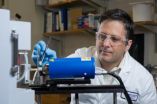(Press-News.org) A survey of emergency contraceptive pills in Peru found that 28 percent of the batches studied were either of substandard quality or falsified. Many pills released the active ingredient too slowly. Others had the wrong active ingredient. One batch had no active ingredient at all.
To detect the fake drugs, researchers at the Georgia Institute of Technology developed a sophisticated approach using mass spectrometry to quickly assess suspected counterfeit drugs and then characterize their chemical composition. The study's results highlight a growing concern for women's health in developing nations.
"A woman who does not want to get pregnant and takes these emergency contraceptives will get pregnant," said Facundo M. Fernández, a professor in the School of Chemistry and Biochemistry, whose lab investigated the contraceptives.
The study was sponsored by the ACT Consortium through a grant from the Bill and Melinda Gates Foundation. The study was published April 18 in the journal PLOS ONE.
Drugs are considered fake or falsified when someone makes a pirate copy of copies a patented drug, with criminal intent. Recent research has found that falsified drugs are a major problem in developing countries. Falsified emergency contraceptives have been reported in Nigeria, Ghana, Kenya, Angola, South America and even the United States. Fake drug manufacturers will copy everything from the pill to the package.
Just as concerning as counterfeit medications are other poor quality medications, such as degraded or substandard drugs. Degraded drugs were once good quality, but lost their efficacy over time, for example after prolonged exposure to the sun in an open air market. Substandard drugs are made by an approved factory, but they don't contain the right active ingredient, contain less active ingredient than they should, or might not dissolve properly. These pills either result from factory error or negligence.
Falsified drugs are the most worrisome, because they may not contain the expected active ingredient, or they may contain the wrong ingredients, including toxic compounds.
In the survey of emergency contraceptives from Peru, the researchers found that seven of the 25 batches analyzed had inadequate release of the active ingredient (levonorgestrel). One batch had no detectable level of the active ingredient.
"We detected that the active ingredient was not there in one batch, instead those samples had a drug called sulfamethoxazole," Fernandez said. "It's a very common antibiotic. It can cause serious adverse reactions in some patients."
For the study, samples of emergency contraceptives were purchased at 15 pharmacies and distributors in Lima, Peru, with 60 tables purchased per sample. Tablets were collected from 25 different product batches encompassing 20 brands labeled as manufactured in nine countries (Argentina, Chile, China, Colombia, Hungary, India, Pakistan, Peru and Uruguay).
Analyzing these samples is time consuming and costly with standard tools, so Fernandez's lab developed a method for a quick screen to identify problematic pills. The first-pass screen then allows the researchers to focus a sophisticated analysis on drugs that are suspected fakes. The drugs that pass the screen will still be closely analyzed, but after the suspected fakes.
Fernandez's lab used a tool called ambient mass spectrometry. Scientists in the lab grasp a tablet with a pair of tweezers and swing it front of the instrument to get a real-time signature of the tablet's chemical composition.
"Very quickly we pick out which ones are the problems," Fernandez said.
Their analysis is a tiered-approach. First they look for the presence and identity of the active ingredient. Then they look to see if the right amount is present. Then they test if the pill properly dissolves. Many sophisticated fake pills might pass all these tests, so the scientists also look at the filler in the pills, known as the excipients, such as lactose and cellulose.
"Many fakes are very sophisticated. They have the right active ingredient and they may even have the right amount, but the excipients or coatings may not be the right ones," Fernandez said.
His students have processed thousands of samples and can spot many fake pills before performing the analysis.
"They touch it a bit with their nails and they try to cut into it and they know it's like a rock, just way too hard," Fernandez said. "The tablets are sometimes so hard that they won't dissolve. That's something that you pick up pretty quickly."
Fernandez's lab is working to make these mass spectrometry tools portable so that researchers might be able to do these analyses in the field.
"You really want to catch these fakes early, at the customs level or at the distribution center level," Fernandez said. "You don't want to wait for this to get to the pharmacy or for somebody to report it."
INFORMATION:
This research is supported by the Bill and Melinda Gates Foundation. Any conclusions or opinions are those of the authors and do not necessarily represent the official views of the sponsoring agency.
CITATION: María Eugenia Monge, et al., "A Tiered Analytical Approach for Investigating Poor Quality Emergency Contraceptives." (PLOS ONE, April 2014) http://dx.plos.org/10.1371/journal.pone.0095353
Counterfeit contraceptives found in South America
More than a quarter of emergency contraceptives were falsified or substandard
2014-04-19
ELSE PRESS RELEASES FROM THIS DATE:
Treating depression in PD patients: New research
2014-04-18
LEXINGTON, Ky. (April 21, 2014) -- A group of scientists from the University of Kentucky College of Medicine and the Sanders-Brown Center on Aging has found interesting new information in a study on depression and neuropsychological function in Parkinson's disease (PD).
Published in the journal Psychiatry Research, the study, which assessed cognitive function in depressed and non-depressed patients with PD, found that the dopamine replacement therapy commonly used to treat motor symptoms of Parkinson's disease was associated with a decline in cognitive performance among ...
Flipping the switch
2014-04-18
Harvard researchers have succeeded in creating quantum switches that can be turned on and off using a single photon, a technological achievement that could pave the way for the creation of highly secure quantum networks.
Built from single atoms, the first-of-their-kind switches could one day be networked via fiber optic cables to form the backbone of a "quantum Internet" that allows for perfectly secure communications, said Professor of Physics Mikhail Lukin, who led a team consisting of graduate student Jeff Thompson and post-doctoral fellow Tobias Tiecke to construct ...
MRI, on a molecular scale
2014-04-18
For decades, scientists have used techniques like X-ray crystallography and nuclear magnetic resonance imaging (NMR) to gain invaluable insight into the atomic structure of molecules, but such efforts have long been hampered by the fact that they demand large quantities of a specific molecule and often in ordered and crystalized form to be effective – making it all but impossible to peer into the structure of most molecules.
Harvard researchers, however, say those problems may soon be a thing of the past.
A team of scientists, led by Professor of Physics and of Applied ...
Stanford researchers rethink 'natural' habitat for wildlife
2014-04-18
Protecting wildlife while feeding a world population predicted to reach 9 billion by 2050 will require a holistic approach to conservation that considers human-altered landscapes such as farmland, according to Stanford researchers.
Wildlife and the natural habitat that supports it might be an increasingly scarce commodity in a world where at least three-quarters of the land surface is directly affected by humans and the rest is vulnerable to human-caused impacts such as climate change. But what if altered agricultural landscapes could play vital roles in nurturing wildlife ...
Finding turns neuroanatomy on its head
2014-04-18
Harvard neuroscientists have made a discovery that turns 160 years of neuroanatomy on its head.
Myelin, the electrical insulating material long known to be essential for the fast transmission of impulses along the axons of nerve cells, is not as ubiquitous as thought, according to a new work lead by Professor Paola Arlotta of the Harvard Stem Cell Institute (HSCI) and the University's Department of Stem Cell and Regenerative Biology, in collaboration with Professor Jeff Lichtman, of Harvard's Department of Molecular and Cellular Biology.
"Myelin is a relatively recent ...
Researchers question published no-till soil organic carbon sequestration rates
2014-04-18
URBANA, Ill. For the past 20 years, researchers have published soil organic carbon sequestration rates. Many of the research findings have suggested that soil organic carbon can be sequestered by simply switching from moldboard or conventional tillage systems to no-till systems. However, there is a growing body of research with evidence that no-till systems in corn and soybean rotations without cover crops, small grains, and forages may not be increasing soil organic carbon stocks at the published rates.
"Some studies have shown that both moldboard and no-till systems ...
Sun emits a mid-level solar flare
2014-04-18
The sun emitted a mid-level solar flare, peaking at 9:03 a.m. EDT on April 18, 2014, and NASA's Solar Dynamics Observatory captured images of the event. Solar flares are powerful bursts of radiation. Harmful radiation from a flare cannot pass through Earth's atmosphere to physically affect humans on the ground, however -- when intense enough -- they can disturb the atmosphere in the layer where GPS and communications signals travel.
To see how this event may impact Earth, please visit NOAA's Space Weather Prediction Center at http://spaceweather.gov, the U.S. government's ...
Researchers find 3-million-year-old landscape beneath Greenland ice sheet
2014-04-18
Glaciers and ice sheets are commonly thought to work like a belt sander. As they move over the land they scrape off everything — vegetation, soil and even the top layer of bedrock. So a team of university scientists and a NASA colleague were greatly surprised to discover an ancient tundra landscape preserved under the Greenland Ice Sheet, below two miles of ice.
"We found organic soil that has been frozen to the bottom of the ice sheet for 2.7 million years," said University of Vermont geologist and lead author Paul Bierman. The finding provides strong evidence that the ...
Religious music brings benefit to seniors' mental health
2014-04-18
A new article published online in The Gerontologist reports that among older Christians, listening to religious music is associated with a decrease in anxiety about death and increases in life satisfaction, self-esteem, and sense of control over their lives. In particular, listening to gospel music is associated with a decrease in anxiety about death and an increase in sense of control.
These associations are similar for blacks and whites, women and men, and individuals of both low- and high-socioeconomic status.
The article, titled "Listening to Religious Music and ...
Ancient DNA offers clues to how barnyard chickens came to be
2014-04-18
Durham, NC — Ancient DNA adds a twist to the story of how barnyard chickens came to be, finds a study to be published April 21 in the journal Proceedings of the National Academy of Sciences.
Analyzing DNA from the bones of chickens that lived 200-2300 years ago in Europe, researchers report that just a few hundred years ago domestic chickens may have looked far different from the chickens we know today.
The results suggest that some of the traits we associate with modern domestic chickens -- such as their yellowish skin -- only became widespread in the last 500 years, ...
LAST 30 PRESS RELEASES:
Scientists boost cell "powerhouses" to burn more calories
Automatic label checking: The missing step in making reliable medical AI
Low daily alcohol intake linked to 50% heightened mouth cancer risk in India
American Meteorological Society announces Rick Spinrad as 2026 President-Elect
Biomass-based carbon capture spotlighted in newly released global climate webinar recording
Illuminating invisible nano pollutants: advanced bioimaging tracks the full journey of emerging nanoscale contaminants in living systems
How does age affect recovery from spinal cord injury?
Novel AI tool offers prognosis for patients with head and neck cancer
Fathers’ microplastic exposure tied to their children’s metabolic problems
Research validates laboratory model for studying high-grade serous ovarian cancer
SIR 2026 delivers transformative breakthroughs in minimally invasive medicine to improve patient care
Stem Cell Reports most downloaded papers of 2025 highlight the breadth and impact of stem cell research
Oxford-led study estimates NHS spends around 3% of its primary and secondary care budget on the health impacts of heat and cold in England
A researcher’s long quest leads to a smart composite breakthrough
Urban wild bees act as “microbial sensors” of city health.
New study finds where you live affects recovery after a hip fracture
Forecasting the impact of fully automated vehicle adoption on US road traffic injuries
Alcohol-related hospitalizations from 2016 to 2022
Semaglutide and hospitalizations in patients with obesity and established cardiovascular disease
Researchers ‘listen in’ to embryo-mother interactions during implantation using a culture system replicating the womb lining
How changing your diet could help save the world
How to make AI truly scalable and reliable for real-time traffic assignment?
Beyond fragmented markets: A new framework for efficient and stable ride-pooling
Can shape priors make road perception more reliable for autonomous driving?
AI tracks nearly 100 years of aging research, revealing key trends and gaps
Innovative techniques enable Italy’s first imaging of individual trapped atoms
KIER successfully develops Korea-made “calibration thermoelectric module” for measuring thermoelectric device performance
Diversifying US Midwest farming for stability and resilience
Emphasizing immigrants’ deservingness shifts attitudes
Japanese eels, climate change, and river temperature
[Press-News.org] Counterfeit contraceptives found in South AmericaMore than a quarter of emergency contraceptives were falsified or substandard






